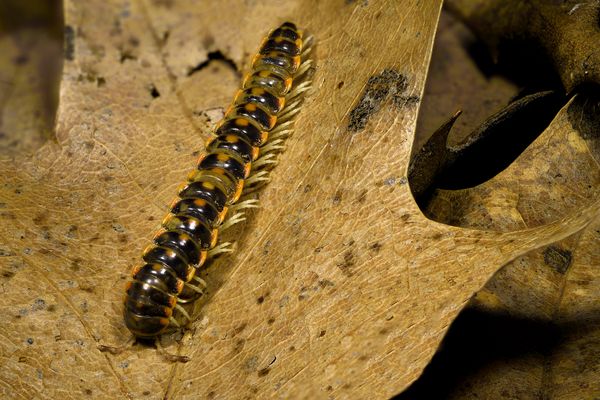Millipede Black and Orange in Habitat
Mar 23, 2019 09:39:34 #
This is my black and orange millipede as found in its natural habitat of the woodland floor among the leaf ground cover and deadfall. It is a companion image of its ventral view which shows details of its body structure.
Thanks again in advance to all those who view and your comments, suggestions and critique are alway highly appreciated.
Thanks again in advance to all those who view and your comments, suggestions and critique are alway highly appreciated.
Mar 23, 2019 10:06:14 #
Mar 23, 2019 10:43:12 #
That is so good and it shows the legs in pairs which a millipede has as against a centipede (Mark taught me that snippet).
Mar 23, 2019 12:44:44 #
You must have turned over a new leaf. I find a lot of specimens that way.
Some millipedes have a very nasty defence system. CYANIDE. Those ones are usually more brightly colored than most. Yellow legs and orange on body in many cases. Does it smell like almonds? Not a funny question. Smell can help ID a lot of arthropods.
If one of that type, it will coil and emit a bit of black liquid that contains the defencive (and offensive) chemical.
The ability to smell cyanide is only in about 40% of humans, so you may not smell it. The millipedes that have this will kill other arthropods. A natural killing jar.
Bill
Some millipedes have a very nasty defence system. CYANIDE. Those ones are usually more brightly colored than most. Yellow legs and orange on body in many cases. Does it smell like almonds? Not a funny question. Smell can help ID a lot of arthropods.
If one of that type, it will coil and emit a bit of black liquid that contains the defencive (and offensive) chemical.
The ability to smell cyanide is only in about 40% of humans, so you may not smell it. The millipedes that have this will kill other arthropods. A natural killing jar.
Bill
Mar 23, 2019 12:53:47 #
Thanks for the specifics on the millipede. My spring Hay Fever has set in so I can't smell (or taste) anything right now (one of the ways to predict that spring is truly on its way now).
This one coils itself up tight like you described so it very well may follow the traits that you described. This is another of my woodland hunts. I take a small rake with me and I turn over the clutter around the deadfalls before I flip them over.
I'm very careful at putting it all back including putting the deadfall back into its devit turned the way that I found it for I discovered that it continues to be productive the next time I come out.
This one coils itself up tight like you described so it very well may follow the traits that you described. This is another of my woodland hunts. I take a small rake with me and I turn over the clutter around the deadfalls before I flip them over.
I'm very careful at putting it all back including putting the deadfall back into its devit turned the way that I found it for I discovered that it continues to be productive the next time I come out.
Mar 23, 2019 13:05:33 #
Put a specimen on tissue. It will show any exudates.
And yes, leave small footprints in nature. After all, it is a lot of creatures' home.
Bill
And yes, leave small footprints in nature. After all, it is a lot of creatures' home.
Bill
Mar 24, 2019 04:09:08 #
OP - Nice close-up. Please remember to always post at least one accompanying 1:1 true macro photo in this section.
Mar 24, 2019 09:19:58 #
Bill, your repurposing the lens camera connection protective cap as a protector for the reversed lens application is very cleaver.
Many seasoned macro pros that I have viewed utilize a reversed lens to produce some stunningly detailed images.
For those who want to learn more about the reverse mounting lens technique, here's the webpage and an online calculator to determine the resulting magnification obtained. http://extreme-macro.co.uk/reversed-lens-techniques/
Many seasoned macro pros that I have viewed utilize a reversed lens to produce some stunningly detailed images.
For those who want to learn more about the reverse mounting lens technique, here's the webpage and an online calculator to determine the resulting magnification obtained. http://extreme-macro.co.uk/reversed-lens-techniques/
Mar 24, 2019 09:30:03 #
Thanks for the feedback. I wanted to get the entire specimen in view that was representative of it in its natural environment so it may have fallen a bit short of 1:1.
There was a companion image post that followed of the ventral view of the millipede that was a 4X view so I'll remember to combine the two images into a single post should I ever do that again.
There was a companion image post that followed of the ventral view of the millipede that was a 4X view so I'll remember to combine the two images into a single post should I ever do that again.
Mar 24, 2019 10:03:09 #
I shot quite a few pictures of a very similar species (Apheloria virginiensis corrugata) at very close range in the Shenandoah Valley. Got a whiff of something and didn't feel right for two days. Later to find as Bill said, that it is a cyanide compound that they use as a defense. Nice shot by the way.
-Doc
-Doc
Mar 24, 2019 10:32:07 #
Thanks, Doc. I guess having Hay Fever right now has its advantages for I couldn't detect a skunk in the room even if it were sitting on my lap. Good news for me though is that it only lasts a week or so.
Mar 24, 2019 23:40:56 #
Oh nice shot -- did you use adquate light for a small aperture or stack it?
Mar 25, 2019 00:04:48 #
docshark wrote:
I shot quite a few pictures of a very similar species (Apheloria virginiensis corrugata) at very close range in the Shenandoah Valley. Got a whiff of something and didn't feel right for two days. Later to find as Bill said, that it is a cyanide compound that they use as a defense. Nice shot by the way.
-Doc
-Doc
A. virginiensis is found along the C and O canal in Montgomery county, Maryland and north across the state. I have put two of these in a jar. Shake and they coil and release the cyanide. Insects added to the jar WILL DIE. Even if not smelled, it is a nerve poison.
Bill
PS. Most millipedes do well on any mild greens that are at the edge of rot. Spinach is well taken. Bits of slimey mushrooms, too. Keep in a plastic box with leaf litter and bark. They breed readily.
Bill
Mar 25, 2019 00:13:18 #
This is a stacked image utilizing constant IKEA LED diffused lighting. I made a bed of fallen leaves by stick-gluing them together and I placed the preserved millipede on it to resemble how I found it in the woods. The shot was taken with a Laowa 60mm 2X Super Macro set to fill the frame with the subject using a Nikon D810 camera.
The multiple images were stacked using Zerene Stacker with minor touch up and sizing in PS CC 2018.
The multiple images were stacked using Zerene Stacker with minor touch up and sizing in PS CC 2018.
Mar 25, 2019 21:05:57 #
If you want to reply, then register here. Registration is free and your account is created instantly, so you can post right away.








